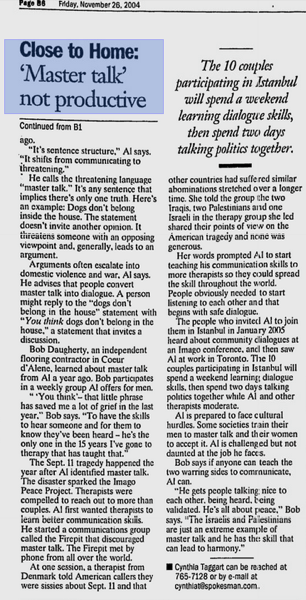Article from an old newspaper:
The Spokesman Review Nov 26 2004


To Imago Therapists | Al Turtle’s Relationship Wisdom: “”
Worth a read, especially the paragraphs on Master Talk
Continue reading “To Imago Therapists | Al Turtle’s Relationship Wisdom”
This little paragraph of mine is from the early ’90s and still catches an idea that drives much of my understanding of psychotherapy.
Theories and Metphors of Cyberspace – Abstracts: “Necessity and Metaphor
Continue reading “Theories and Metphors of Cyberspace- Abstracts”
My posting about skeuomorphism in the last post, and earlier this year, is not just because I’m an Apple user (I won’t say fan). It iOS because it is related to my long interest in metaphor. (You can see all my posts with this tag by clicking the Metaphor tag at the bottom of this post).
What I liked about the article in the previous post is that it makes a distinction between skeuomorphism that assists usability, when it assisted in the early days. and now when it might even obscure things.
The the tricky thing that a purist would face if they were to avoid skeuomorphism altogether is that it is impossible. Online it is ALL metaphor, all abstraction.
Buttons
Folders
Views
Posts
Commands
Pages
Desktops
There is very little if anything that is native to the digital world. Digits, for example.
This principle applies even to abstractions in ordinary language:
Root
Tree
Sea
These words can all go well beyond their literal meaning.
This is of interest as it has deep implications for psychological work.
The psyche, like cyberspace is immaterial and we use metaphors from the material world to talk about the invisible
What touched you?
have a heart.
The psyche is not the body. We use metaphase from the body to describe it.
The current wave of bring research is fascinating but it is not related to the psyche, there is a huge category mistake being foisted upon the psychotherapy world.
The question is of interest too in relation to creativity
We use brushes in digital art programs, and they can use watercolour or oils. Where is the native digital form? (there are some!) Light is used to create ‘depth’ backup creating fake shadows. The glossy icons apple uses are created using fake shine. (Will Jony Ives remove that?)
While we have electronic music it is mostly through skeuomorphic instruments that we create it.
Always, no sometimes, think it’s me, but you know I know when it’s a dream.
I think I know I mean a ‘Yes’ but it’s all wrong, that is I think I disagree.
Let me take you down, ‘cos I’m going to Strawberry Fields.
Nothing is real and nothing to get hungabout.
Strawberry Fields forever.
Strawberry Fields forever.
The Noimetic View of Meaning | Psychology Today
Rethinking Psychology
How to shed mental health labels and create personal meaning
by Eric Maisel, Ph.D.Continue reading “The Noimetic View of Meaning | Psychology Today”
Small Graces Mapping a Route of Beauty to the Heart of the World
by Jason Sugg
Submitted in partial fulfilment of the requirements for the degree of
Master of Arts in Counseling Psychology
Pacifica Graduate Institute
14 February 2012
Has a whole section on Participation Mystique and I-Thou.
Well researched.
Below is an enticing quote. The reason I’m attracted to this work is that I think that the very relationships we are discussing here, participatory, with the ego dropped, with heightened awareness of self and other, are also the relationships that are needed between therapist and client, and partners in a relationship. It’s not well grasped: they are vital to knowing each other. We can’t know others at this level of consciousness without participating in the relationship with full role reversal. Continue reading “Small Graces: Mapping a Route of Beauty to the Heart of the World”
Another snippet, scouring the web without actually reading the book! (see last post)
PEP Web – The Origins and History of Consciousness: By Erich Neumann.:
“In his Introduction the author writes: ‘It is the task of this book to show that a series of archetypes is a main constituent of mythology, that they stand in an organic relation to one another, and that their stadial succession determines the growth of consciousness. In the course of its ontogenetic development, the individual ego consciousness has to pass through the same archetypal stages which determined the evolution of consciousness in the life of humanity’ (p. xvi). ‘The individualized conscious man of our era is a late man, whose structure is built on early, pre-individual human stages from which individual consciousness has only detached itself step by step’ (p. xx). Hence, Part I deals with ‘The Mythological Stages in the Evolution of Consciousness’ in three sections: A, ‘The Creation Myth’; B, ‘The Hero Myth’; C, ‘The Transform”
I’m thinking of my 18 month old granddaughter – she is certainly developing her own sense of self. Stages makes sense, but what is the sequence.
The relational paradigm is surely a higher stage of consciousness, it includes individuation which can’t be attained without it.
Further to my exploration of participation mystique in the last two posts I’m led – as some may expect – to:

The amazon page has excellent reviews, the description of the book is at the end of this post.
Below are a couple of quotes that give me the sense that he thinks the participation mystique is of a primitive or childlike state of unity that is lost.
This is interesting as it might relate to attachment theory and Moreno’s notion of the matrix of all identity. The idea that it is a primitive state (presumingly leading to individuation) might skip the importance of adult attachment as Susan Johnson talks about it.
Is adult attachment really a stage of not being quite grown up. Schnarch might say that?
Here is a quote by an anonymous reviewer on Amazon:
An interesting side effect of this view of consciousness is the resultant synthesis of linear and cyclical notions of Time. To Neumann, Time is an open-ended linear progression (development) which is recursively cyclical. The recursion occurring in the subject self’s perception of time: That the individual’s subjective perception of time in an early part of his development, corresponds with the Human’s perception of Time in a corresponding earlier point in history.
For example, using Neumann’s framework, one can see the ‘mythological’ persona and teachings of Jesus (and his semi-contemporary Buddha) as the collective expression of the coming ‘personal’ transcendence and autonomy of the Ego (as in: “The Kingdom is in You!”).
Perhaps we are moving forward (and backwards) to the relational paradigm?
Quotes I found from the book follow:
This integration was not necessarily anything mysti-
cal, as the rather nebulous term participation mystique might
lead one to suppose. All it means is that, in the original group,
the solidarity of the group members is to be conceived more on
the analogy of an organ in relation to the body, or of a part in
relation to the whole, than of a part in relation to the sum, and
that the whole exercised a paramount effect, so that the ego
could only free itself very slowly from the tyranny of the group.
This late birth of the ego, consciousness, and the individual is
an incontestable fact.
~~~
PSYCHOLOGICAL STAGES IN THE DEVELOPMENT OF PERSONALITY – 295
Originally it was impossible for the ego
to distinguish the source of these images, for at the stage of
participation mystique an outside could not be perceived as distinct from an inside; the two sets of images overlapped, so
that experience of the world coincided with inner experience.This original phase, when consciousness was a sense organ,
is marked by the functions of sensation and intuition, i.e., the
perceptive functions 84 which are the first to appear both in the
development of primitives and in that of the child.
The Origins and History of Consciousness (Bollingen Series,42): Erich Neumann,R. F. C. Hull,C. G. Jung: 9780691017617: Amazon.com: Books: “Book Description
Publication Date: 1970
The first of Erich Neumann’s works to be translated into English, this eloquent book draws on a full range of world mythology to show that individual consciousness undergoes the same archetypal stages of development as has human consciousness as a whole. Neumann, one of Jung’s most creative students and a renowned practitioner of analytical psychology in his own right, shows how the stages begin and end with the symbol of the Uroboros, or tail-eating serpent. The intermediate stages are projected in the universal myths of the World Creation, Great Mother, Separation of the World Parents, Birth of the Hero, Slaying of the Dragon, Rescue of the Captive, and Transformation and Deification of the Hero. Throughout the sequence the Hero is the evolving ego consciousness.”
Following on from the last post the idea of the primacy of the relationship is beautifully expressed by Edward Hirsh. This time in relationship to poetry.
In the last post with the passage from “A Bridge to Unity” the idea of participation mystique comes up in the context of shamanism.
Moreno’s tele however is universal it is not a special event – not shamansm or poetry. Tele is ever-present and the stuff we work with in relationships.
Edward Hirsh puts it beautifully though:

Continue reading “In the Beginning Is the Relation by Edward Hirsch”
Freud, Moreno, Jung… methods are known by their founders.
This is because they are working in the realm of relationships. They are included in the science.
They are not working with things.
Marx is the same.
The objective thing they are working with is not objective in the way things are – at least things on the surface are objects.
In so far as we are part of such a modality we are part of a community around that person. We are part of a community of practice. A language community.
The Buddhists have lineage, so do psychologists but we don’t acknowledge that so easily.
It would be better to acknowledge our whakapapa in the psychological realms of our work in a more conscious way.
Later: Sunday, 7 January, 2018
Love that idea of our psychological whakapapa. Maybe there is a whakapapa of science too?
I think I’d like to research and rewrite the Moreno one. I think it is not so much existential as relational .